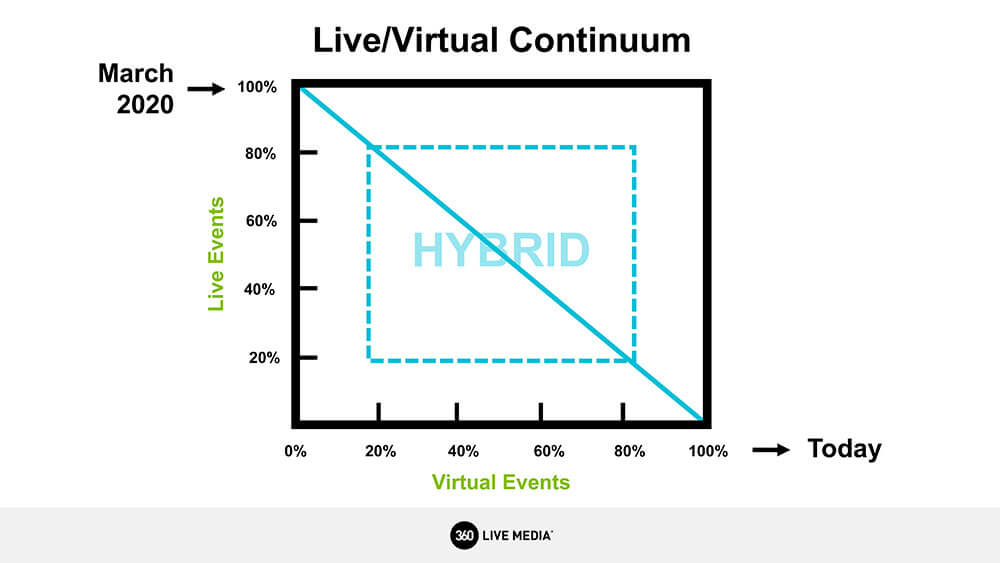
Event strategists should think about designing their 2021 events based on four different “domains:” live hub, Live remote, virtual, and digital, or social media.

Don Neal
Warren Buffet once said, “Only when the tide goes out do you discover who’s been swimming naked.” Well, the tide has gone out and the fragility of the traditional association model — which relies heavily on an annual face-to-face event for revenue and member engagement — has been brought into stark relief by the pandemic. We need to adopt a new strategy to set our events on a new path of success. There are three reasons why this will work:
- There is demand. Your members, exhibitors, sponsors, and your entire industry and profession needs to sharpen their skills, buy and sell goods and services, and make connections. The core raison d’être for events has never been stronger than during this time of lockdown and social isolation.
- The industry that sells to your members needs access to their customers and prospects. You provide a critical distribution and sales channel to them. You have been the “shopping mall” for your industry to do business. It’s time to open up again and give the marketplace a chance to get back to business.
- Every member of your board of directors, every association CEO/executive director, and CFO knows that your event is the lifeblood of your operating income. Events must once again be drivers of revenue and profitable organizational growth.
There is still real opportunity for your event portfolio to succeed in a post-COVID world. The question is: How can you get your events back to a level of acceptable performance after months of cancellations, postponements, and poor-revenue-generating virtual events when 2021 looks so uncertain?
Clarity
The most important step right now is to decide what to do and get started. And deciding in the midst of the fog, fear, uncertainty, and doubt depends on establishing a foothold where you are. But as we’ve come to realize, it’s hard to know where you are when none of us has ever been here before.
You can gain the clarity you need to progress by assessing your association’s 2021 event based on these seven statements:
- The venue we’ve selected to host our 2021 event will be open.
- Our sponsors and exhibitors will be ready and willing to participate.
- Our members, past attendees, and new audiences will travel to and attend a live event.
- We have sufficient insurance and legal safeguards in place to protect our organization if we host a live event.
- We are prepared to augment our live event with a virtual/digital experience.
- We have the resources, staffing, and budget to design and executive a live and virtual hybrid event.
- Our board of directors, volunteers, and leadership support a live event.
Based on your answers to the above seven questions, plot your next major event on the diagonal line in the box above based on the mix of in-person and virtual event delivery you think will be possible for your organization.
Then, convey where you see your event on that line to your team and your leadership and get them — and your members — on the same page. Once you do that, no matter what changes take place or how many disruptions you continue to face, you have a point of clarity that allows you to begin planning.

Based on your answers to seven questions, plot your next major event on the diagonal line.
Bottom Line
Never before has “no money, no mission” been more true. Revenue and operating income are essential for your organization to succeed and at this moment, it is the one thing that every association is struggling to generate.
Even if you had your major event before COVID-19 hit, even if you received a large event cancellation insurance payment, and even if you hosted your first virtual event over the past several months, you know that long-term revenue recovery is essential to rebuild your organization going forward. None of these “one-offs” will sustain you for the long term.
And for many of you, this means a financially successful event is job No. 1. Most of the initial virtual events held right after the lockdowns delivered a small fraction of what their comparable in-person versions did. We all know the reasons:
- 80 percent of virtual events were offered free.
- Exhibitors and sponsors shifted funds to next year, canceled, or reduced their investments in your virtual event.
- The drop-off rate from registrants to those who participated to the end was higher than expected.
What you need is a much-improved second virtual event. The No. 1 driver for the success of your next virtual event is to build an economic model that engages the audience, delivers the right audience to your exhibitors and sponsors, and maximizes the income for your association or society.
Not only that, you must deliver the right kind of access. If you completed your first virtual event, you’ve already learned that exhibitors and sponsors aren’t happy with logos plastered on a virtual event platform or being one of hundreds of companies listed in an online directory, or simply being “sponsored” by your organization giving them better placement for eyeballs.
You must evolve and offer new access that is more relevant, makes a bigger impact, and produces a much higher ROI for your partners. We’ve introduced 20 new sources of “sponsorable inventory,” such as a virtual focus group, virtual product sampling, product placement, and virtual hosted buyer exchanges. And, if you’re really ready to step up, you should consider a year-round commercial marketplace that opens up a whole new world of revenue opportunity.
For your next virtual event:
- Introduce a pricing approach that is more viable than free (people expect less and the no-show rate is as high as 50 percent).
- Build a revenue strategy into your event design process — don’t just bolt on a list of exhibitors, virtual booths, or sponsored companies with prominent locations.
- Adopt a ground-up design that isn’t a virtual conversion of an in-person event but takes a fresh approach — much like that of an interactive TV show that is designed to generate deeper connections and deliver significant top-line revenue and a substantial operating profit.
Hybrid
Yes, we all seem to be in agreement: Next year is going to be the year of hybrid. However, there is a better way to plan for 2021 than to just try to blend in-person and virtual.
Start where you plotted your event on that diagonal line and think about designing your 2021 event based on four different “domains”— not just a scaled-back version of your live event with some virtual, on-demand, and video footage from your live event (see illustration at top of page).
The first domain or environment is the “live hub” — your studio of 100-500 socially distanced people in one location, with high production values. This is your core center of energy, education, commerce, and excitement. You can’t plan on producing another virtual event in 2021 with a series of boxes on a screen like your 2020 event — a bland version of Hollywood Squares but with- out the humor or personalities. You need to think like a TV producer, Hollywood agent, Broadway set designer, and a Twitch host to keep the attention of your audience now that they will have a year of virtual meetings under their belts. There will be little patience or interest in the same old Zoom call.
The second environment is the “live remote” domain — a series of small footprint locations that provide local relevance and a nice “spoke” that’s connected to the hub. This may be five to 10 people in a hotel or outdoor area who rotate in throughout the day. Think of it as foreign correspondent reporting live from Boston, L.A., Sydney, and London. You build in local flavor, dramatize the global appeal of your event, and give local audiences an opportunity to engage in-person. And you give industry partners plenty of meaningful access to the audience.
The third domain is virtual, but with so much more vitality, entertainment, and “watchable” content than we all have become accustomed to. You have to think like a TV producer who has to keep a viewing audience engaged. You are competing with all of the other screens in your audience’s life.
The fourth domain is digital, but in a different sense: the four social-media platforms — Instagram, Facebook, Linked-In, and Twitter. You can use these social channels to augment the virtual experience with user groups, sponsored commercials, live feeds of content, video, product demos, etc.
While we are all navigating through what seems like a global shared experience, remember that we are all experiencing this crisis in our own way. Your organization’s success and viability has never been more important. Your industry and profession need you.
Your members and your event audiences are looking to you to be a beacon in the storm and for your event to work as hard as possible to do the job they want done — to engage, educate, inspire, connect, shop, buy, sell, and all of the specific things they’ve come to rely on from you.
If you follow this playbook, get good advice, unify your team, and get your leadership on board, the next 12 months will be remembered as the beginning of the renaissance of your organization, a new future for the industry you represent, and a new chapter for you and your career.
Don Neal is founder and CEO of marketing, strategy, and experience agency 360 Live Media.
